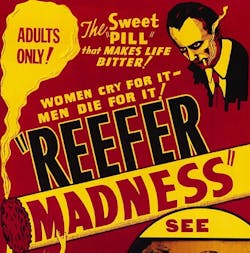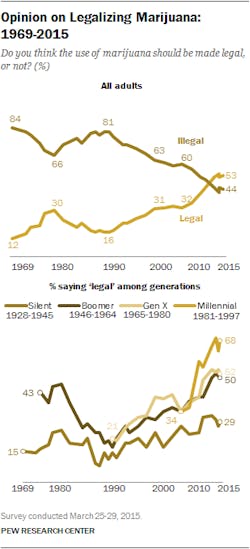Marijuana is one of America’s fastest growing industries, and the profits the manufacture and sale of legalized pot could generate are sky high. Whatever your personal opinion is, the euphoria and munchie-inducing weed is clearly a cash crop, expecting to reach $21.8 billion by 2020, according to ArcView Market Research.
For a country that has lost 5 million manufacturing jobs since 2000, growing pot doesn’t seem so half-baked. For equipment companies, such as John Deere, that have been forced to lay off thousands, a blossoming pot industry could at least stem the tide. If weed was as legal to produce and consumes alcohol, there's no telling how many manufacturers could benefit. At the very least, Mexican cartels wouldn't reap any rewards.
Photo: Justin Sullivan/ Getty Images
Like any industry, there are ethical and social downsides to consider. But it’s no less controversial or potentially dangerous than fracking.
Of course, the biggest downside is that no matter what state you’re in, it’s illegal on a federal scale. That doesn’t mean the DEA will bust down the doors of your local dispensary, but it does mean your business could pay up to 70% in federal taxes.
That’s a major buzz kill, but the truth usually is.
Here are 20 more facts that should help you decide if the growth and distribution of legalized weed would be a good thing for American economy, or if that idea is just up in smoke:
1) On April 17, Pennsylvania became the 24th state to legalize medical marijuana.
2) Four states — Alaska, Colorado, Oregon, and Washington — have legalized cannabis for recreational use, as well.
3) It’s also legal in Washington D.C, which is appropriate because George Washington grew hemp on all five of his farms. The industrial strain is thought to be about as potent as the bag or oregano you bought that one time in high school.
4) Recreational marijuana profits reached $998 million in 2015, a 184% increase from 2014.
5) The production and sale of marijuana has led to 10,000 jobs in Colorado, according to the Marijuana Industry Group.
DENVER, CO - APRIL 20: Fast Eddy Aki'a of Hawaii smokes a joint as thousands gathered to celebrate the state's medicinal marijuana laws and collectively light up at 4:20 p.m. in Civic Center Park April 20, 2012 in Denver, Colorado. Colorado goes to the polls November 6 to vote on a controversial ballot initiative that would permit possession of up to an ounce of marijuana for those 21 and older. (Photo by Marc Piscotty/Getty Images)
6) In Colorado, the state sales tax is 2.9% for medical marijuana and 10% for retail; the excise tax for large wholesale weed is 15%.
7) This earned the Centennial State $70 million in taxes in 2014, compared to the $42 million from alcohol.
8) On Nov. 8, California voters will vote on the Adult Use of Marijuana Act, which states “Californians 21 and older would be permitted to possess up to an ounce of marijuana, up to 8 grams of concentrated cannabis and up to six plants.”
9) The transaction of an “undetermined amount of marijuana” between Stanford and MIT in the early 1970s has been regarded as the first e-commerce sale.
10) A lb of corn costs 7 cents, while a lb of legal marijuana costs more than $2,00.
Illegal growers often sneak their seeds into fertile cornfields. Photo: toronto.ctvnews.ca
11) This year, farmers will lose $70 on every acre of corn or soybeans they sow, according to AgResource Co. Those are the country’s two highest yield crops.
12) Agricultural subsidies cost taxpayers about $20 billion a year, while legalizing marijuana would generate $8.7 billion in federal and state tax revenue annually, according to a 2010 study from Cato Institute.
13) Cultivating marijuana indoors is equal to the energy to power 1.7 million American homes or 1% of the nation’s total consumed energy and growing one kilo of marijuana indoors is equal to driving across the country seven times.
14) Producing one joint is equal to leaving a 100-watt light bulb on for 25 hours, says the journal Energy Policy.
15) As recently as 2008, Mexico provided as much as two-thirds of the marijuana consumed in America annually, says Beau Kilmer, co-director of the Drug Policy Research Center at the Rand Corp. think tank.
16) That is now estimated to be one-third, says Alejandro Hope, a security and drug analyst in Mexico.
17) According to a Pew research poll, 53% favor the legal use of marijuana, while 44% are opposed.
Public perception of marijuana has changed a lot since the 1930s.
18) Of those that oppose its legalization, 43% say marijuana generally hurts society and is bad for individuals, and 30% say it’s a dangerous addictive drug.
19) A 2012 Duke University study found smoking weed four or more times a week from age 13 to 38 could drop a person’s IQ by 8 points, and is cited on a National Institute of Health Drug Abuse website.
20) Other researchers immediately claimed that study was flawed, and a 2014 University College of London study found that there is no correlation between marijuana and loss of intelligence, though "alcohol use was found to be strongly associated with IQ decline."















